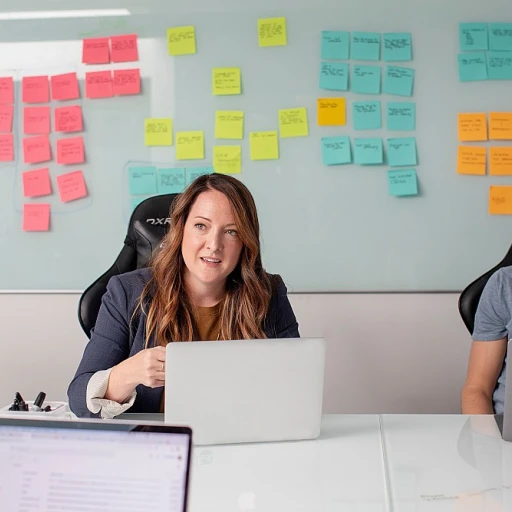
Understanding Integrated Planning
Deciphering the Elements of Integrated Planning
The concept of integrated planning is a cornerstone for the successful implementation of continuous learning initiatives. This strategic approach amalgamates various elements that go beyond traditional planning methods. In simple terms, integrated planning aligns strategic goals with practical execution across different sectors, like urban development and transportation infrastructure, to facilitate a unified organizational mission. Each planning process starts with recognizing the multi-dimensional nature of the organizational ecosystem. It demands a cross-functional approach to synchronize different departments and processes. This synchronization ensures that every plan, be it related to mobility, energy, or public transport systems, aligns with long-term strategic development. By incorporating strategic planning, organizations can create robust integrated plans that are not only resilient but also adaptable to future challenges. It helps avoid the pitfalls of isolated decision-making by promoting holistic solutions. Applying integrated planning does not end at theory; it encompasses initiatives like transportation planning and urban energy management. These are about making informed planning decisions that account for current and future project requirements, concluding in both sustainable and strategic public and private sectors. Discover more about this comprehensive planning approach and how it enhances your learning journey with our 360-degree workflow. This is not just about assimilating information; it's about mastering the process of integrated planning to adapt and excel in a dynamic environment.Setting Clear Learning Objectives
Articulating Core Skills and Knowledge
Understanding how to set clear learning objectives is crucial for anyone looking to master integrated planning. This process begins with defining specific skills and knowledge areas where you want to see improvement. By doing so, individuals can align their learning strategies with broader organizational goals and transportation infrastructure needs. Strategic goals play a vital role in shaping your learning plan. Whether you're involved in public mobility or managing urban development, creating objectives that are aligned with both current and future demands can enhance the effectiveness of your learning. This will enable you to make informed decisions regarding integrating strategic plans across various levels of the organization.Aligning Learning with Business Strategy
A thorough understanding of how your learning objectives relate to the organization's strategic plan is essential. Professionals focusing on energy planning or those engaged in urban mission initiatives must link their learning to business strategy. This ensures that the development of integrated plans supports the organization's mission and addresses any overlaps in the planning process. Understanding the elements integrated into strategic goals helps ensure that your learning objectives influence both traditional planning methods and innovative approaches. Creating learning objectives that benefit from integrated planning decisions can lead to substantial growth and advancement within your professional sphere.Navigating the Complexities of Integrated Planning
Consider the cross-functional aspects of integrated planning. Setting clear objectives involves an appreciation of each element's role in the planning process. For example, those involved in transportation planning need to identify how their skills and knowledge impact the development of transportation infrastructure and the wider strategic goals of urban planning. By navigating these complexities, you'll be better positioned to tailor your learning objectives, ensuring they address all necessary areas. This approach bridges the gap between long-term strategic goals and day-to-day planning tasks, ultimately leading to more cohesive and productive outcomes for your organization. For more insights into how strategic planning and learning objectives coexist, consider reading about enhancing business efficiency with Six Sigma cloud solutions in ERP. This resource provides valuable guidance on integrating learning with business strategy, particularly in dynamic and evolving environments.Creating a Personalized Learning Roadmap
Building Your Learning Pathway
A personalized learning roadmap serves as the backbone of any successful continuous learning journey, ensuring that your efforts are directed and effective. The planning process aligns with a strategic approach, laying down the infrastructure necessary for both immediate and long term strategic goals. By developing integrated plans that encompass your current capabilities and future aspirations, you can create a robust framework for achieving your objectives. To start crafting your learning pathway, consider the following elements:- Identify Key Areas: Prioritize the areas most crucial to your professional development and align them with your organization's mission. This prioritization reflects the benefits integrated with developing a strategic plan encompassing both personal and organizational goals.
- Determine Learning Levels: Assess whether your focus should be on foundational, intermediate, or advanced levels within each area. This assessment helps in setting a clear learning trajectory and aligning with strategic goals.
- Incorporate Cross-Functional Elements: In today’s dynamic environment, skills such as transportation planning or energy-efficient strategies, once seen as niche, can now considerably augment your skill set across various sectors, including urban management and public mobility.
- Set Milestones and Timeframes: Establish short-term, mid-term, and long-term timelines to assess progress. The transportation infrastructure of a plan hinges on clear milestones that allow for adaptive decision making and flexibility.
Utilizing Resources Effectively
Maximizing Resource Utilization for Lifelong Learning
Effectively leveraging resources is a critical aspect of the integrated planning approach in continuous learning. Ensuring you have access to the right resources will empower you to strategically progress towards your learning objectives. When dealing with such planning processes, it is important to consider various levels of resource integration, from infrastructure to public and organizational support.
In the context of continuous learning, transportation planning is about more than getting from point A to point B. It involves strategic decisions regarding how you'll transport yourself mentally and physically through educational journeys. Think of resources as different modes of transportation in your learning mission—each resource serving a unique and pivotal role in transforming your educational aspirations into tangible outcomes.
- Identify both traditional and cross functional resources available to you, such as online courses, community study groups, or mentorship opportunities within your current network.
- Consider the infrastructure needed for your long term learning development. This can mean updating your technological tools or setting a dedicated learning space in your home or workplace.
- Assess your organization's support, whether through funding educational programs or offering strategic time allowances for learning.
Adopting a strategic plan enhances how effectively you use resources, ensuring that your learning objectives align with both current and future goals. By integrating various elements of continuous learning resources into your strategy, you'll be better positioned to handle unforeseen challenges and make necessary planning decisions that foster growth.
Ultimately, the benefits of integrated planning and resource utilization manifest in a holistically developed learning strategy. As you implement and adapt your strategy, you’ll find that the thoughtful cultivation of your educational resources supports your broader term strategic goals. Remember, every decision you make has the potential to shape not only your learning journey but also the energy and mobility with which you embrace lifelong education.
Overcoming Challenges in Continuous Learning
Tackling Hurdles in Your Learning Journey
Continuous learning is an ambitious pursuit, often accompanied by its fair share of hurdles. Recognizing and addressing these challenges is fundamental to maintaining momentum and achieving your learning goals. Here are some common challenges and strategies to overcome them:- Balancing Work and Learning: For many, integrating a learning plan with a busy work schedule is no small feat. A cross-functional approach, similar to transportation planning, can help you synchronize your learning objectives with professional responsibilities. Allocating dedicated time slots each week and prioritizing your learning pathway can lead to more effective outcomes.
- Access to Resources: Infrastructure for learning may differ based on your organization or public availability. Developing a strategic plan to identify potential resources in your domain and seek out online platforms, such as those focusing on transportation infrastructure or urban mobility, can enhance your overall learning experience.
- Information Overload: In today’s digital age, the vast amount of available information can be overwhelming. Implementing an integrated plan that focuses on long-term strategic plans can help streamline the content you consume, directing energy towards more impactful learning opportunities.
- Lack of Motivation: Motivation can wane over time, especially without clear strategic goals. Establishing a mission that aligns with your personal or professional advancement is crucial. Like transportation planning in urban areas, a clear vision helps steer movements, inspiring you to remain focused.
- Decision Making in Learning: The planning process significantly influences decision-making regarding what to learn. Adopting an integrated planning approach, addressing both current and future educational needs, can enhance decision-making efficiency, guiding you through both traditional planning and innovative methodologies.
Evaluating and Adjusting Your Learning Plan
Tracking Progress and Reassessing Your Learning Path
The effectiveness of any strategic plan relies heavily on evaluation and adaptation, which is especially true in the realm of continuous learning. By implementing a systematic approach to assess your learning journey, you empower yourself to make informed decisions that align with your long-term strategic goals. Here are some pivotal elements to consider when evaluating and adjusting your learning plan:
- Regular Assessment: To ensure you are on the right path, integrate a regular assessment schedule into your learning process. This could involve setting specific intervals to review your progress against the initial objectives set. Such evaluations provide insights into the efficacy of the strategies utilized and highlight areas requiring focus and adjustment.
- Feedback Channels: Incorporate feedback as a vital component of your learning strategy. Feedback from peers, mentors, or other resources within your organization can identify areas for improvement, ultimately enriching your learning experience.
- Data-Driven Decisions: Utilize data-driven approaches to your assessments. By leveraging metrics and analytics, you can objectively measure aspects of your learning journey, understanding where adjustments are required.
- Adaptation of Strategies: Continuous learning necessitates flexibility. As your needs evolve, so should your strategies. Reassess your approach at various levels—whether it's the integration with your current infrastructure or how public and urban mobility advancements influence your learning.
- Future-Proof Learning: Stay ahead by continuously forecasting future transportation infrastructure developments or urban planning shifts. By anticipating these changes, you can adjust your learning plans to maintain relevance in the rapidly evolving landscape of integrated planning.
This ongoing evaluation and adaptation not only benefit your learning journey but also ensure that your planning decisions remain robust and effective. Remember that overcoming challenges in learning is part of the development process, rendering you better equipped to reach your strategic objectives in any mission.












